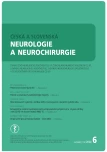Validation study and introduction of the new TEPO sentence comprehension test for children aged 3–8 years
Authors:
G. Solná 1,2; B. Červenková 3,4
Authors place of work:
Neurologické oddělení, Nemocnice AGEL, Ostrava – Vítkovice
1; Psychiatrická klinika 1. LF UK, Praha
2; Ústav speciálněpedagogických studií, Pedagogická fakulta, UP, Olomouc
3; Oddělení neonatologie, FN Brno
4
Published in the journal:
Cesk Slov Neurol N 2022; 85(6): 477-483
Category:
Původní práce
doi:
https://doi.org/10.48095/cccsnn2022477
Summary
Aim: The ability to understand can be impaired in children with neurodevelopmental disorders, including developmental language disorder, autism spectrum disorder, attention deficit disorder and learning disability. The aim of this article is to introduce a new test, TEPO, which is designed to assess sentence comprehension in children aged 3–8 years. Materials and methods: Data collection was conducted between 2018 and 2021, the basic set of 863 children consisted of healthy children (N = 335), children with articulation disorder (N = 296) and children with developmental language disorder (N = 232). The norms were validated on children without developmental language disorder and were defined per three months of age using percentile bands. The deficit band is defined by performance in the ≤ 5th percentile. Results: Significant diagnostic validity of the test was demonstrated (discrimination across age in groups of healthy children and children with articulatory disorders compared to the group of children with language disorders was statistically significant; p < 0.001) with concurrent validity (rs= 0.826 and rs= 0.863, respectively) and internal validity (Cronbach’s α = 95), high sensitivity and specificity (82.4 -100 % and 87–100 %, respectively). Negative and positive predictive value and cut-off score were also determined. Conclusion: TEPO has the potential to screen comprehension in children across all elemental diagnoses in which comprehension impairment occurs. It also allows a partial differential-diagnostic distinction of the pathomechanism of the disorder, i.e., if the errors in comprehension are due to difficulties in understanding lexical or grammatical-syntactic structures.
Keywords:
developmental language disorder – comprehension diagnosis – TEPO comprehension test
Zdroje
1. Fisher EL. Systematic review and meta-analysis of predictors of expressive language results among late speakers. J Speech Lang Hear Res 2017; 60 (10): 2935–2948. doi: 10.1044/2017_JSLHR-L-16-0310.
2. Norbury CF, Gooch D, Wray C et al. The impact of nonverbal ability on prevalence and clinical presentation of language disorder: evidence from a population study. J Child Psychol Psychiatry 2016; 57 (11): 1247–1257. doi: 10.1111/jcpp.12573.
3. Eadie P, Conway L, Hallenstein B et al. Quality of life in children with developmental language disorder. Int J Lang Commun Disord 2018; 53 (4): 799–810. doi: 10.1111/ 1460-6984.12385.
4. Pospíšilová L. Vývojová dysfázie současnosti. Listy klinické logopedie 2019; 3 (1): 48–54. doi: 10.36833/ lkl.2019.011.
5. Bishop DV, Snowling MJ, Thompson PA et al. Phase 2 of CATALISE: a multinational and multidisciplinary Delphi consensus study of problems with language development: terminology. J Child Psychol Psychiatry 2017; 58 (10): 1068–1080. doi: 10.1111/ jcpp.12721.
6. Pospíšilová L, Hrdlička M, Komárek V. Vývojová dysfázie – funkční a strukturální korelace. Cesk Slov Neurol N 2021; 84/117 (3): 237–244. doi: 10.48095/cccsnn 2021237.
7. Friedereci AD, Chomsky N, Berwick R et al. Language, mind and brain. Nat Hum Behav 2017; 1 (10): 713–722. doi: 10.1038/ s41562-017-0184-4.
8. Smolík F, Bytešníková I. Screening poruch jazykového vývoje v raném věku: přehled a představení dotazníku SDDS. Čes Slov Pediat 2020; 75 (8): 484–489. doi: 10.1016/j.jcomdis.2021.106146.
9. Kapalková S, Lizáková R. Hodnotenie úrovne porozumenia u detí v ranom veku do tretieho roka. Listy klinické logopedie 2021; 5 (2): 4–11. doi: 10.36833/lkl.2021.009.
10. Seidlová Málková G, Smolík F. Diagnostika jazykového vývoje. Diagnostická baterie pro posouzení vývoje jazykových znalostí a dovedností dětí předškolního věku. Praha: Grada Publishing 2014.
11. Bolceková E, Preiss M, Krejčová L. Token test pro děti a dospělé. Otrokovice: Propsyco 2015.
12. Grimm H, Schöler H. Heidelberger Sprachentwicklungstest. Göttingen: Verlag für psychologie Dr. C. J., Hogrefe 1991.
13. Dlouhá O. Poruchy vývoje řeči. Praha: Galén 2017.
14. Košťálová M, Bednařík J. Screening afázie: MASTcz. [online]. Dostupné z URL: http: //www.fnbrno.cz/Article.asp?nDepartmentID=1355&nArticleID=2298&nLanguageID=1.
15. Nohová L, Vitásková K, Kršková M et al. Test porozumění větám (TPVcz): Metodická příručka. Olomouc: Univerzita Palackého v Olomouci 2022.
16. Bartoš A. Dvě původní české zkoušky k vyšetření paměti za tři minuty – Amnesia Light and Brief Assessment (ALBA). Cesk Slov Neurol N 2019; 82/115 (4): 420–429. doi: 10.14735/amcsnn2019420.
17. Bartoš A, Diondet S. Test Amnesia Light and Brief Assessment (ALBA) – druhá verze a opakovaná vyšetření. Cesk Slov Neurol N 2020; 83/116 (5): 535–543. doi: 10.14735/amcsnn2020535.
18. ePubli webová knihovna. [online]. Dostupné z URL: https: //publi.cz/.
19. Bishop DVM. The test for reception of grammar, version 2 (TROG 2). London: Pearson 2003.
20. Peña ED, Spaulding TJ, Plante E. The composition of normative groups and diagnostic decision making: shooting ourselves in the foot. Am J Speech Lang Pathol 2006; 15 (3): 247–254. doi: 10.1044/1058-0360 (2006/023).
21. Amorosa A, Kleinhans-Lintner J, Von Bender-Fisser U. An experimental study with the Token Test in dysphasic and other learning-disabled children. Z Kinder Jugendpsychiatr Psychother 1980; 8 (3): 288 -299.
22. Gutbrod K, Michel M. On the clinical validity of the Token Test with brain damaged children with and without aphasia. Diagnostica 1986; 32 (2): 118–128.
Štítky
Dětská neurologie Neurochirurgie NeurologieČlánek vyšel v časopise
Česká a slovenská neurologie a neurochirurgie

2022 Číslo 6
- Metamizol jako analgetikum první volby: kdy, pro koho, jak a proč?
- Nejčastější nežádoucí účinky venlafaxinu během terapie odeznívají
- Pregabalin je účinné léčivo s příznivým bezpečnostním profilem pro pacienty s neuropatickou bolestí
- Moje zkušenosti s Magnosolvem podávaným pacientům jako profylaxe migrény a u pacientů s diagnostikovanou spazmofilní tetanií i při normomagnezémii - MUDr. Dana Pecharová, neurolog
Nejčtenější v tomto čísle
- Doporučení pro vývojovou dysfázii – verze 2022
- Validační studie a představení nového testu porozumění větám TEPO pro děti ve věku 3–8 let
- Nové farmakologické možnosti v léčbě Alzheimerovy nemoci
- Pletencové svalové dystrofie
